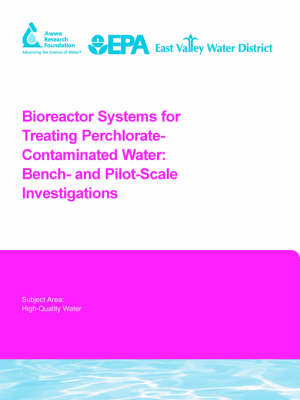Water Research Foundation Report
1 total work
Bioreactor Systems for Treating Perchlorate-Contaminated Water
by B. Logan, B. Min, K. Kim, J Miller, D. LaPoint, J. Batista, J. Liu, P. Evans, A. Chu, and S. Price
Published 1 March 2005
The objective of the project was to develop in the laboratory, and test in the field, a biological water treatment process for treating perchlorate-contaminated water. Bench- scale experiments were conducted on three processes: a packed bed reactor amended with soluble substrates (acetate); a hydrogen gas fed four-phase unsaturated trickle-type packed column; and a membrane-immobilized biofilm reactor. Based on these tests, one reactor system, an acetate-fed packed bed reactor (PSU-O4 system), was selected for further testing in pilot-plant tests at the Texas Street well field in Redlands, California.All three systems successfully removed perchlorate at rates sufficient to achieve an acceptable level of perchlorate removal for subsequent treatment for potable use. Pilot- scale tests at the Redlands site in California showed that perchlorate could be removed to non-detectable levels ( 4 µg/L) in the fixed bed reactor. Backwashing the reactor weekly to remove biomass was needed to assure acceptable performance. In Phase 1, bench-scale reactors were constructed to test the ability of these different bioreactors to degrade perchlorate to low concentrations. The packed-bed reactors (saturated and unsaturated flow conditions) were tested in the environmental engineering laboratories at Penn State University, while the membrane-immobilized reactor experiments were conducted at the University of Nevada, Las Vegas. Most experiments were conducted using an artificial groundwater spiked with perchlorate at various concentrations. In the last series of experiments, nitrate was added to the water to study its effect on perchlorate degradation. These results were then compared to perchlorate removal using actual water samples taken from the Redlands-Crafton site containing perchlorate at concentrations of 60–80 ppb. In Phase 2, pilot-scale reactors were tested at the Redlands Site in California to examine the ability of the system to reduce perchlorate to concentrations of less than 4 ppb. The reactor systems described in this report provide a relatively inexpensive method for treating perchlorate-contaminated water. As a side benefit of the process, nitrate is also removed from the water. The process is biological in nature and thus provides a natural method for removing perchlorate from drinking water. Originally published by AwwaRF for its subscribers in 2004. This publication can also be purchased and downloaded via Pay Per View on Water Intelligence Online - click on the Pay Per View icon below
